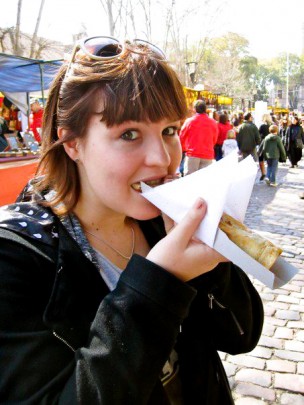
Dulce de leche is possibly my favorite phrase in Spanish. Literally translated, it means “sweet of milk,” but you will soon realize that it is the most addictive, delicious thing you have ever tasted. Before I came to Argentina, I thought I had self-control when it came to sweets. Fast forward to me standing in front of the fridge eating dulce de leche with a spoon at 6 a.m. after a night out in Buenos Aires. Oh well, at least I’m experiencing the personal growth the Office of International Studies called an integral part of studying abroad!
Dulce de leche has two key ingredients: milk and sugar. The thick, spreadable consistency and distinctive taste come from slowly simmering the two until the sugar caramelizes and about a sixth of the milk evaporates.
Deceptively simple but incredibly tasty, Argentines claim to have invented this magical mixture. Yes, Argentine national pride extends to confectionery—they’re definitely trying to prove some kind of point by adding dulce de leche to every dessert/yogurt/pastry possible. Dulce de leche is actually common across Latin America, though it goes by many names.
In Chile, it is called manjar. Some Chileans will tell you that manjar is intrinsically Chilean and actually very different from dulce de leche. When I went to Chile I did a taste test and, honestly, it really is the same thing. But don’t tell that to a Chilean culinary nationalist.
Dulce de leche is super easy to make, but it does require a long time stirring in front of the stove. If you’re worried about a repetitive strain injury to your spoon-wielding arm, try Haagen Dazs’s Dulce de Leche flavor. Even if it is a watered-down Americanized incarnation, it’s still sumptuous. Starbucks makes a dulce de leche frappuccino too, if you’re into that kind of thing (meaning a squirt of high fructose corn syrup and caramel coloring corrupting your coffee beverage). To my surprise, Starbucks didn’t come up with this coffee-dulce de leche combination; a dollop of dulce de leche appears as a common addition on most café menus in Buenos Aires.
And if reading about sweet, creamy, sticky, caramelized dairy products is getting you a little bit hot and bothered, may I suggest a different kind of sweet treat? Dulce de leche flavored lube (yes, it exists) is available at New York’s famous feminist sex shop, Babeland and on their website. At $8, it’s probably the same price as that frappuccino.
Dulce de Leche
Recipe adapted from Rebecca Caro’s food blog, From Argentina With Love.
Ingredients
– 4 cups milk
– 2 cups sugar
– 1 tsp. baking soda
– 1 tbs. vanilla extract
1. Bring the milk to a boil in a sauce pan (heavy bottomed if you have one).
2. Add the sugar and vanilla extract. Make sure to stir with a whisk until the sugar is completely dissolved.
3. Simmer on medium low until it turns into caramel, about 2-3 hours. Stir occasionally, making sure the bottom isn’t burning, but don’t mix in the foam that appears on the top of the mixture.
How do you know when it’s done? It should have a rich tan or brown color and smooth texture. Consistency depends on personal taste and is up to you. If you spoon a little onto a plate, it should be thick enough to not run all over the plate. If it’s still too runny, just keep simmering a little longer. Let it cool before serving, and store in the fridge for up to a month.


Leave a Reply